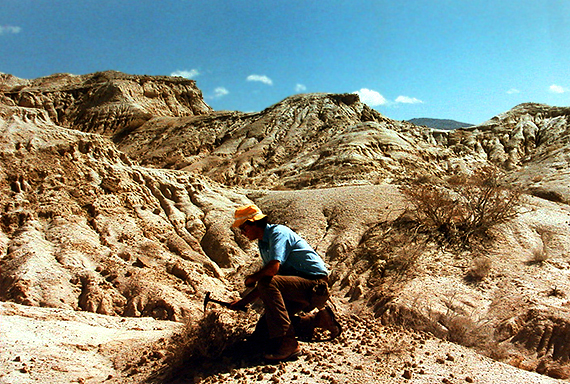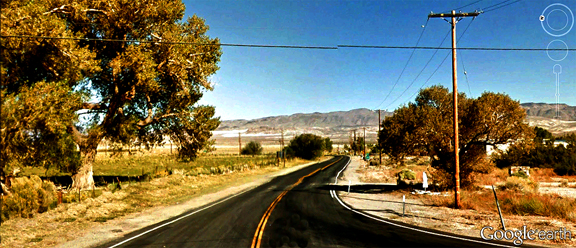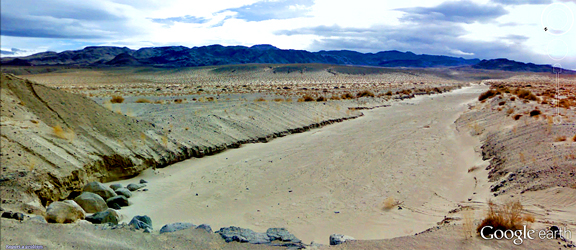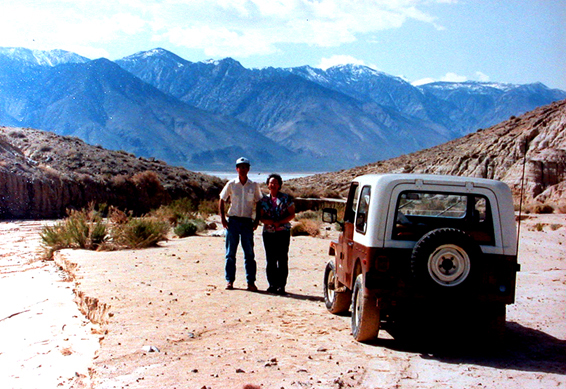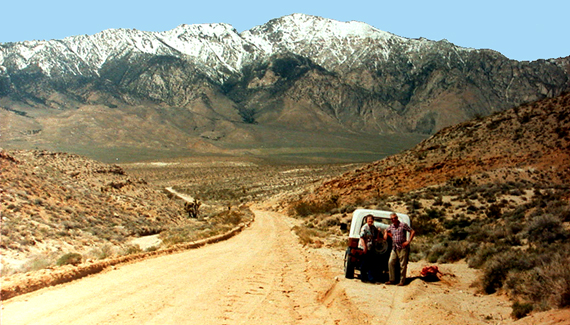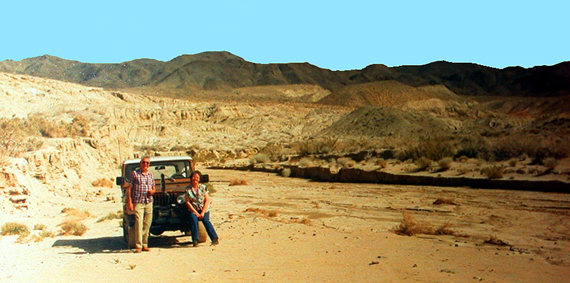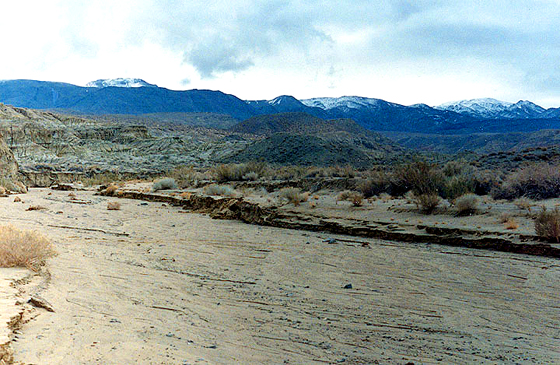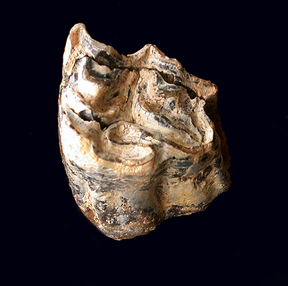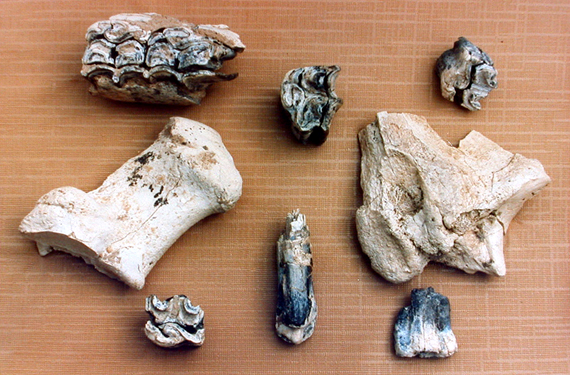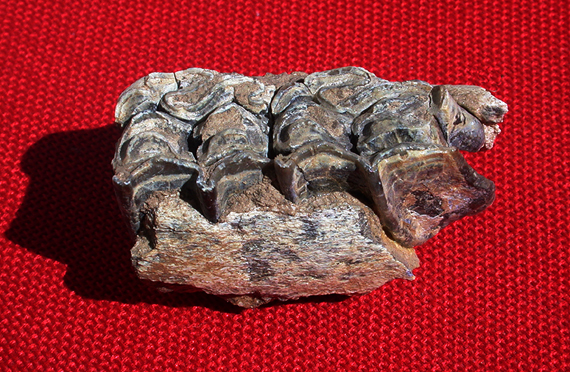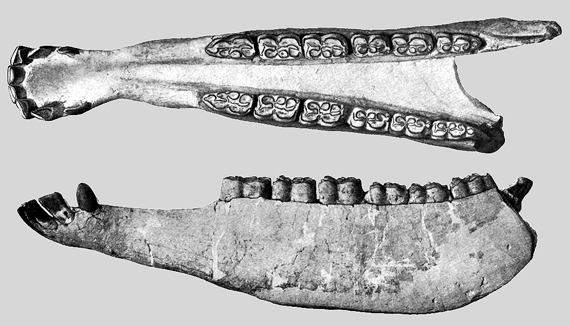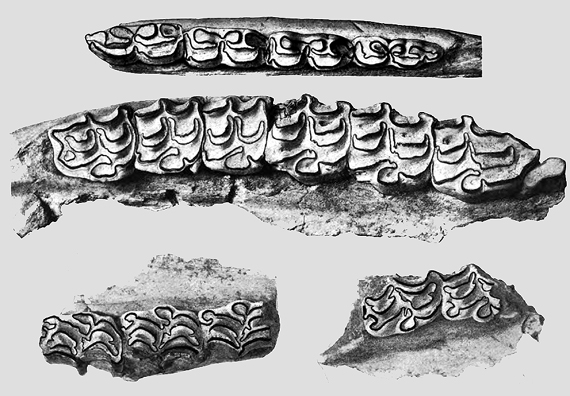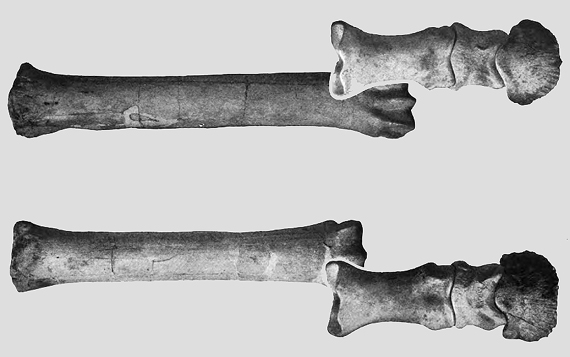|
Introduction
Visit the Coso Range Wilderness in Inyo County, California,
west of Death Valley National Park at the southern end of California's
Owens Valley, where vertebrate fossils some 4.8 to 3.0 million
years old can be observed in the Pliocene-age Coso Formation:
It's a paleontologically significant place that yields many species
of mammals, including the remains of Equus simplicidens, the
Hagerman Horse, named for its spectacular occurrences
at Hagerman Fossil Beds National Monument in Idaho; Equus
simplicidens is considered one the earliest known members
of the genus Equus, which includes the modern horse
and all other equids.
Please note that fossil collecting is not allowed
within the designated Coso Range Wilderness, except by special
permit issued by the Bureau of Land Management--a permit given
only to individuals who matriculated from an accredited university
with a minimum B.S. degree, or represent a museum whose credentials
meet the necessary standards of excellence.
And now for the obligatory words of caution. Endemic
to the Mojave Desert of California, including the Las Vegas,
Nevada, region by the way, is Valley Fever. This is a potentially
serious illness called, scientifically, Coccidioidomycosis, or
"coccy" for short; it's caused by the inhalation of
an infectious airborne fungus whose spores lie dormant in the
uncultivated, harsh alkaline soils of the Mojave Desert. The
Coso Mountains lie near the northern known edges of Valley Fever
prevalence within the Mojave Desert province. When an unsuspecting
and susceptible individual breaths the spores into his or her
lungs, the fungus springs to life, as it prefers the moist, dark
recesses of the human lungs (cats, dogs, rodents and even snakes,
among other vertebrates, are also susceptible to "coccy")
to multiply and be happy. Most cases of active Valley Fever resemble
a minor touch of the flu, though the majority of those exposed
show absolutely no symptoms of any kind of illness; it is important
to note, of course, that in rather rare instances Valley Fever
can progress to a severe and serious infection, causing high
fever, chills, unending fatigue, rapid weight loss, inflammation
of the joints, meningitis, pneumonia and even death. Every fossil
enthusiast who chooses to visit the Mojave Desert must be fully
aware of the risks involved.
Field Trip
To The Coso Bone-Bearing Badlands
An inviting route to Death Valley National Park is State
Highway 190 out of Olancha in California's southern Owens Valley.
Not only is this a much-scenic and reliably accessible pathway
to one of the world's favorite haunts, but it also places visitors
within convenient striking distance of a most fascinating vertebrate
fossil locality in the federally established and administered
Coso Range Wilderness--an area no longer accessible to motor
vehicles, of course, though it's still wide open for inspection
by foot and other non-mechanized means.
Perhaps not a few folks remain unfamiliar with this particular
area, and I can surely see why. You just can't spot the bone-bearing
beds from the asphalt and, besides, it's more than probable that
many a traveler has their eyes fixed on the ever-looming and
impressive hulk of the Panamint Mountains up ahead--the range
which guards the western side of Death Valley, proper.
The Cosos are that at first blush nondescript piece of
territory off to the east and southeast as you speed along the
southern fringes of Owens Lake between Highway 395 and the intersection
with State 136 to Keeler. They are primarily of igneous origin,
born of fire and brimstone, the savage spewings of explosive
Cenozoic Era molten lavas in combination with Mesozoic Era batholithic
instrusive granites--as unlikely a source of fossil specimens
as one could be excused for believing. Yet, tucked way back in
the rugged Coso recesses lie the eroding badlands of an ancient
lake system which yields up many fossil bones.
The vertebrate remains that await discovery in the Coso
Mountains come from the appropriately named Coso Formation, which
is upper Miocene to upper Pliocene in geologic age, dated with
considerable radiometric confidence at 6.0 to 3.0 years old.
And all fossil specimens described from the Coso Formation derive
from a restricted sequence some 4.8 to 3.0 million years old.
This means that statigraphically speaking the Coso mineralized
skeletal material falls within the range of what vertebrate paleontologists
call the Blancan Stage of North American Land Mammal Age chronology--that
is to say, a geologic interval roughly 4.75 to 1.80 million years
ago. Indeed, the Pliocene Coso Formation yields up one of the
premiere Blancan Stage mammal localities in all the US West.
Petrological analysis demonstrates that the Coso hydrologic-volcanic
system deposited a composite aggregate of roughly 500 feet of
arkosic sandstones, shales, claystones, diatomite (a variety
of rock composed almost entirely of diatoms, a photosynthesizing
microscopic single celled algae), air fall volcanic ash, and
basalts in a relatively localized lacustrine (lake) basin influenced
by subordinate fluviatile (stream) and alluvial conditions that
contributed substantial detrital constituents to the continuously
operating three million-year regime of sedimentary-igneous accumulations--all
subjected on occasion to geophysically stressful extensional
(pulling apart of a portion of the earth's crust) and block-faulting
forces.
Significantly, near the conclusion of its depositional
history--between four and three million years ago--the Coso Formation
starts to record a dramatic influx of clastic-detrital debris
now eroding with sudden onslaught from a fault-controlled uplift
and eastward rotational tilting of the eastern front of the central
to southern Sierra Nevada--a still-active and fully on-going
creative geologic process that continues to fashion the great
elevations and breathtaking contrasts in topographic relief so
spectacularly characteristic of the eastern face of the Sierra
Nevada; the northern Sierra of course has stood at approximately
the same height as present since at least the early middle Eocene
Epoch some 48 million years ago, while the central to southern
Sierran area has been substantially uplifted during the past
five million years.
Geologist J. R. Schultz was the first scientist to investigate
this fossil fauna. He led experienced field technicians from
the California Institute of Technology on two extensive expeditions
to the Cosos, the first in the winter of 1930-'31, then another
during the summer of 1936. Schultz eventually published his geological
and paleontological findings in: Schultz,
J. R., 1937, A late Cenozoic vertebrate fauna from the Coso
Mountains, Inyo County, California, Carnegie Institute of
Washington Publication 487, pages 75-109. Among his many
fossil mammal descriptions were meadow mice, rabbits, haenoid
dogs, very large grazing horses--one of which was eventually
recognized by paleontologists as the world-famous Hagerman Horse
(one of the oldest members of the genus Equus, which includes
all modern horses and other equids)--peccaries, slender camelids,
and a short-jawed mastodon. Additional Coso Formation fossil
material, secured by teams of professional paleontology explorers
who succeeded Schultz's ground-breaking investigations, includes
undescribed ostracods (a minute bivalved crustacean), algal bodies
(stromatolitic developments created by species of blue-green
algae), diatoms (a microscopic single-celled photosynthesizing
single-celled algae), fish, a vole (the famous Cosomys primus,
named in honor of its occurrence in the Coso Mountains), a large-headed
llama, a bear--and, prolific quantities of pollen, palynological
specimens that add invaluable paleobotanical information to the
Coso story.
The Pliocene Coso Formation pollens come from what paleobotanists
call the Haiwee Florule, situated near the shores of Haiwee Reservoir
approximately five miles south of the Coso Range vertebrate fossil
locality. They were recovered from brownish siltstones in the
lower portions of the Coso Formation by the late paleobotanist
Daniel I. Axelrod and W. S. Ting through sophisticated--and extraordinarily
dangerous--laboratory procedures, involving the use of perhaps
the most potent/unforgiving acid known to exist, hydrofluoric
acid, whose efficient destructive activity on human tissue is
so rapid and overwhelming that permanent damage to epidermis,
muscles, and nerves occurs before one even feels any degree of
discomfort or pain after skin exposure. Published documentation
of that palynological study can be found in the scientific paper,
Late Pliocene Floras East of the Sierra Nevada, by D.
I. Axelrod and W. S. Ting, University of California Publications
in Geological Sciences volume 39, number 1, issued November 7.
1960.
The extensive fossil flora that Axelrod and Ting collaboratively
examined from the Pliocene Coso Formation includes such conifers
as: Incense Cedar; White Fir; Grand Fir; California Red Fir;
Bristlecone Pine; Jeffrey Pine; Sugar Pine; Singleleaf Pinyon
Pine; Western White Pine; Lodgepole Pine; Ponderosa Pine; Douglas-Fir;
Western Hemlock; and Giant Sequoia--in addition to the following
angiosperms: White Alder; Water Birch; Hazelnut; Blue Elderberry;
Pacific Dogwood; California Black Oak; Interior Live Oak; Silk
Tassel Bush; Black Walnut; Bush Poppy; Snow Bush; Deer Brush;
June Berry; Rock Siraea; Thimbleberry; Coyote Willow; Pacific
Willow; White Squaw Current; Red Prickly Currant; Kellog Sierran
Currant; Sierra Gooseberry; California Slippery Elm; and Zelkova.
Axelrod and Ting concluded that the overall paleo-environmental
aspect of the Coso Formation Haiwee Flora most closely resembles
today's Sierran pine-fir forests along the moist western slopes
of California's Sierra Nevada. Based on the known annual precipitation
totals necessary to sustain modern examples of such luxuriant
forest vegetation found in the fossil flora, Coso Pliocene times
experienced an estimated minimum of 35 inches of rain per year--whereas
today the area lies within what geographers categorize as the
Mojave Desert-Great Basin transition zone, which in the vicinity
of the Coso fossil occurrences receives a scant three to five
inches of rain per year, with soaring summer temperatures that
frequently exceed 110 degrees Fahrenheit; in forested Sierran
regions where modern-day members of the fossil flora now grow,
temperature rarely exceed 85 degrees F.
While fossil pollens lie preserved in older horizons of
the Coso Formation, all the vertebrate remains occur within a
rather narrow zone in the upper part of the Coso sedimentary
deposits; they are found in a buff-colored arkosic (composed
primarily of the mineral feldspar) sandstone which weathers into
subangular chunks. Often, the mineralized mammalian material
can be found already weathered out of the sandstone and in the
softer claystone a few feet below the sandstone. The fossil-bearing
horizon shows up within most of Pliocene exposures of the Coso
Formation, so there is a lot of territory to explore. Schultz's
original bone localities lie about two and a half miles from
State Route 190; reaching them now involves strenuous hiking
through rugged, desolate desert terrain. "In the old days,"
though, one could negotiate a four-wheel drive vehicle up a system
of packed sand desert washes, through magnificent outcrops of
the bone-bearing Coso Formation, to within a quarter mile or
so of the Schultz fossil quarry. As a matter of fact, with the
aid of "trusty" CJ5 and CJ7 jeeps, I managed to thread
my way back to the familiar box canyon parking spot several memorable
times before the Coso Range became a protected wilderness region--a
federally mandated designation which means, naturally, that without
a special BLM permit you can't keep anything you find there (paleontological,
or otherwise)--except in a camera.
Although many Coso bones observed in surface exposures
will be fragmental, that doesn't necessary indicate that what
you've found can't be identified, eventually. In addition to
occasionally encountering isolated-scattered occurrences of complete
teeth and associated jaws, watch out, too, for such ostensibly
insignificant specimens as fractured limb sections and other
assorted incomplete post cranial skeletal elements that reveal
a crucially preserved articulating surface (a ball or socket
joint, for example). These are prize finds, indeed, paleontologically
speaking, as experts in vertebrate paleontology should be able
to determine exactly what kind of animal they came from. There
are certainly a good many fossil bones waiting to be found and
subsequently photographed where they reside in situ in their
sandy to clay-rich sedimentary environment. Probably the most
efficiently productive method is to locate the fossil-bearing
bed (it will tilt with the moderate dip of the sedimentary rocks,
and often it occurs on a precipitous hill-slope--so be careful),
then hike it out for as long as it is traceable. Some extensions
of the bone horizon are quite prolific, while others seem pretty
much barren.
All the way around, this is a great area in which to get
some exercise.
Though not necessarily during summer times, one must observe
with at least a modicum of sagacious deference to the months
of June through September in this part of the Northern Hemisphere,
when daytime temperatures regularly exceed 105 degrees. More
comfortable--and physically safer--hiking weather in this geographical
transition zone between the northwestern Mojave Desert and westernmost
Great Basin is traditionally encountered during mid to late Fall
and mid Spring.
Still and all--speaking of good old hot summertimes--I
must admit that my first acquaintance with the Coso bones was
during a particularly ultra-thermal early July. This was a number
of years ago, when I resided in coastal southern California.
This was a number of years ago, before the Coso Range became
off limits to off-road vehicles. This was a number of years ago,
before the Coso Range became the Coso Wilderness.
The preliminary circumstances: My father and I wanted to
escape the dismal, fog-bound coast of Santa Barbara. We wanted
to get out into the desert in the worst way possible. Thus, we
turned deaf ears to weather reports of 100-plus degrees on the
Mojave Desert.
Because when Coso paleo-urges strike...well, there's no
turning back.
At the crossroads in Olancha, at a filling station, somebody
was talking about 108 in the shade. That somebody was assessing
the conservative side of the situation. I was inhaling fire,
it seemed. Somebody else, the service attendant, would only shake
his head when I pointed, with what could have easily been interpreted
as braggadocious indifference to the brutal elements and the
imminent dangers they could present, down the road in the direction
of Death Valley in reply to his inquiry as to our destination.
At what our maps indicated was the correct intersection
of State Route 190 with a dry wash a number of miles beyond Olancha,
I idled the CJ5 jeep. No matter that the heat from the engine
overpowered the stifling furnace of the Mojave. We re-checked
our maps; and then decided to take yet another look at them.
This was the place all right, and the wash leading off into the
Coso Mountains invited us onward; not to mention the obvious
that the potential bone bonanza up ahead was a prime motivator.
I got the jeep down in the middle of the wash with the four-wheel
drive already engaged, primed for any kind of sandiness we might
encounter.
We should have been so lucky as to get stuck in some mere
sand.
What happened--and that within sight of the bone-bearing
badlands we had traveled some 250 miles to explore--was somewhat
more than we had expected. Smoke on a sudden came billowing from
beneath the hood, and the nauseating pungence of electrical wires
on fire became intense; this, just before the jeep jerked to
a halt, cold. We leaped to the situation with canteens in hand,
flipping open the hood to already charred remains of wires--and
we doused what we could. Then I ran with hectic unsteadiness
back to the rear of the jeep where we kept our extra water supply.
The five gallon container felt like a bag full of air as I plunged
its contents to the flames, dousing them repeatedly until only
sickening smoldering remained.
So what did we do next? Consternate? Curse? Nope, we took
a hike (fossil mania has its prerogatives). Just up ahead a few
hundred feet began the badlands exposures of the Coso Formation.
And it was with not a little anticipation that we struck out
to them with our remaining full canteens, leaving behind for
the moment that dead-in-the sand jeep. We crisscrossed those
ancient rocks while following the bone-bearing bed, and the paleontological
zeal propelled us further in that glaring, brutal heat than I
could have possibly foreseen.
But broken down jeeps wait for every man. A sobering mechanical
analysis of the predicament proved that the wiring had been fried
to a crisp when the horn mechanism had jarred loose, shorting
out the system: too many bumpy roads too many times taken. Aided
and abetted by the recollection of some basic electrical knowledge
garnered from a recent workshop (studying diagrams and such from
the jeep's manual from the curbside at home), we figured pretty
quickly that we could safely bypass the obvious tactic of securing
assistance when stuck out in the boondocks all alone, where nobody
in the world who knows where you are is there to lend a hand--in
other words, yelling and yelling like crazy at the top of your
lungs. No, this was too easy.
We chose to resort to a plan of action which in theory
we had only heard about; this entailed an electrical trick usually
quite controversial, but one worth trying under the circumstances.
It was decided that if we were ever to get out of that wash alive
we would have to "hot wire" the contraption.
The prospects did not excite us much. What if an officer
of the law should wander by and catch us in the hot wiring act?
Perish the thought! Yet, we persisted and pursued and made it
back to tell the tale.
And the moral of this story? Don't toot your horn too often
about how you can brave the desert elements, I suppose.
We maneuvered the jeep back to Santa Barbara the same way
it got to the Cosos to begin with--towed behind an Open Road
camper/RV, and later on down the line (with some creative electrical
finagling) we finally got a brand new wiring harness installed,
and the four wheel drive "contraption" was by all indications
good as new, and good to go: A new-and-improved jeep that actually
managed to survive numerous additional deep desert backroad adventures.
To all who visit the Coso badlands, don't be surprised
if someday you happen to spot a four-wheel drive vehicle stranded
along State Route 190, hood raised, the driver nowhere to be
seen. If this is the case, simply follow the boot prints in the
sand up a dry desert wash into the Cosos until you come upon
a fossil hunter, nose bent to the ground, examining a 4.8 to
3.0 million year-old mammal bone.
|
